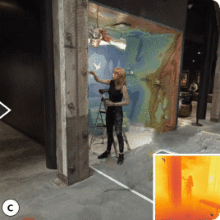Herzlichen Glückwunsch an Dieter Schmalstieg, Alexander von Humboldt Professor für Visual Computing, und Kollegen. Für ihre Arbeit erhielten sie auf der diesjährigen ISMAR Konferenz gleich zwei Preise.
Paper Impact Award
Für ihre gemeinsame Publikation „Experiences with Handheld Augmented Reality“ (ISMAR 2007) erhielten Dieter Schmalstieg und sein Co-Autor Daniel Wagner (Direktor, Snap Inc.) den ISMAR Paper Impact Award. Mit dem Award werden Publikationen für ihren besonders langfristigen Einfluss innerhalb der Forschungscommunity und darüber hinaus ausgezeichnet.
Paper Abstract
In this paper, we present Studierstube ES, a framework for the development of handheld Augmented Reality. The applications run self-contained on handheld computers and smartphones with Windows CE. A detailed description of the performance critical tracking and rendering components are given. We also report on the implementation of a client-server architecture for multi-user applications, and a game engine for location based museum games that has been built on top of this infrastructure. Details on two games that were created, permanently deployed and evaluated in two Austrian museums illustrate the practical value of the framework and lessons learned from using it.
Best Paper Honorable Mention
Ebenfalls erfolgreich war das Paper „Exemplar-Based Inpainting for 6DOF Virtual Reality Photos.“ Shohei Mori, Dieter Schmalstieg und Denis Kalkofen erhielten für ihre Arbeit einen Best Paper Honorable Mention Award.
Paper Abstract
Multi-layer images are currently the most prominent scene representation for viewing natural scenes under full-motion parallax in virtual reality. Layers ordered in diopter space contain color and transparency so that a complete image is formed when the layers are composited in a view-dependent manner. Once baked, the same limitations apply to multi-layer images as to conventional single-layer photography, making it challenging to remove obstructive objects or otherwise edit the content. Object removal before baking can benefit from filling disoccluded layers with pixels from background layers. However, if no such background pixels have been observed, an inpainting algorithm must fill the empty spots with fitting synthetic content. We present and study a multi-layer inpainting approach that addresses this problem in two stages: First, a volumetric area of interest specified by the user is classified with respect to whether the background pixels have been observed or not. Second, the unobserved pixels are filled with multi-layer inpainting. We report on experiments using multiple variants of multi-layer inpainting and compare our solution to conventional inpainting methods that consider each layer individually.
Über die Konferenz
Das 22. IEEE International Symposium on Mixed and Augmented Reality (ISMAR) fand vom 16. bis 20. Oktober als hybride Konferenz in Sydney, Australien, statt. ISMAR bringt jedes Jahr führende Forschende aus den Bereichen Augmented Reality (AR), Mixed Reality (MR) und Virtual Reality zusammen. Die Konferenz umfasst zwei Tage mit Workshops, Tutorien und Wettbewerben sowie drei Tage mit Präsentationen von wissenschaftlichen Arbeiten, Postern und Demonstrationen.


